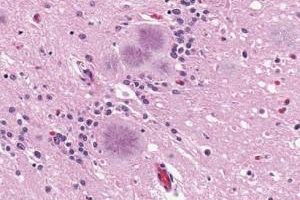mad cow disease
Needle-in-a-haystack search identifies potential brain disease drug
Scientists who examined more than 10,000 chemical compounds during the last year in search of potential new drugs for a group of untreatable brain diseases, are reporting that one substance shows unusual promise. The early positive signs for so-call…
Unfolding pathogenesis in Parkinson’s
The study, published in the Journal of Clinical Investigation, reveals that damaged alpha-synuclein proteins (which are implicated in Parkinson’s disease) can spread in a ‘prion-like’ manner, an infection model previously described for diseases such…
New method takes snapshots of proteins as they fold
People have only 20,000 to 30,000 genes (the number is hotly contested), but they use those genes to make more than 2 million proteins. It’s the protein molecules that domost of the work in the human cell. After all, the word protein comes fro…
Research identifies drug target for prion diseases, ‘mad cow’
LEXINGTON, Ky. (Jan. 4, 2011) − Scientists at the University of Kentucky have discovered that plasminogen, a protein used by the body to break up blood clots, speeds up the progress of prion diseases such as mad cow disease.
This finding m…
NIH study suggests that early detection is possible for prion diseases
A fast test to diagnose fatal brain conditions such as mad cow disease in cattle and Creutzfeldt-Jakob disease in humans could be on the horizon, according to a new study from National Institutes of Health scientists. Researchers at NIH’s National I…
New prion discovery reveals drug target for mad cow disease and related illnesses
The joy of a juicy hamburger could make a comeback thanks a new discovery by scientists from the University of Kentucky. In a new research report in the December 2010 print issue of The FASEB Journal (http://www.fasebj.org), scientists found that a …
Iowa State, USDA researchers discover eye test for neurological diseases in livestock
AMES, Iowa — The eyes of sheep infected with scrapie — a neurological disorder similar to mad cow disease — return an intense, almost-white glow when they’re hit with blue excitation light, according to a research project led by Iowa State Univ…
UCSF’s Prusiner receives President’s National Medal of Science
UCSF Nobel laureate Stanley B. Prusiner, MD, UCSF professor of neurology and director of the Institute for Neurodegenerative Diseases, today (Oct. 15, 2010) was named to receive the National Medal of Science, the nation’s highest honor for science a…
Eyes of cattle may become new windows to detect mad cow disease
The eyes may or may not be windows to the soul, as the old adage goes, but scientists are reporting evidence that a peek into the eyes of cattle may become the basis for a long-sought test to detect infection with the agent that causes Mad Cow Disea…
Pressure, heat help reduce prion infectivity in processed meats
The combination of high temperature and very high pressure in the preparation of processed meats such as hot dogs and salami may effectively reduce the presence of infective prions while retaining the taste, texture, and look of these meats, according to a study in today?s Proceedings of the National Academy of Sciences (PNAS) Early Edition.
Clue to prion formation found, offers step toward treating puzzling diseases
Prions–their existence is intriguing and their links to disease are unsettling. These unconventional infectious agents are involved in mad cow disease and other fatal brain illnesses in humans and animals, rattling prior assumptions about the spread of infections. Dartmouth Medical School biochemists studying the mysteries of these prion particles have discovered a novel step in their formation. Their results, reported in a recent issue of Biochemistry could help provide a new approach for therapy against prion diseases. The team, headed by Dr. Surachai Supattapone, assistant professor of biochemistry and of medicine, includes Ralf Lucassen and Koren Nishina.

